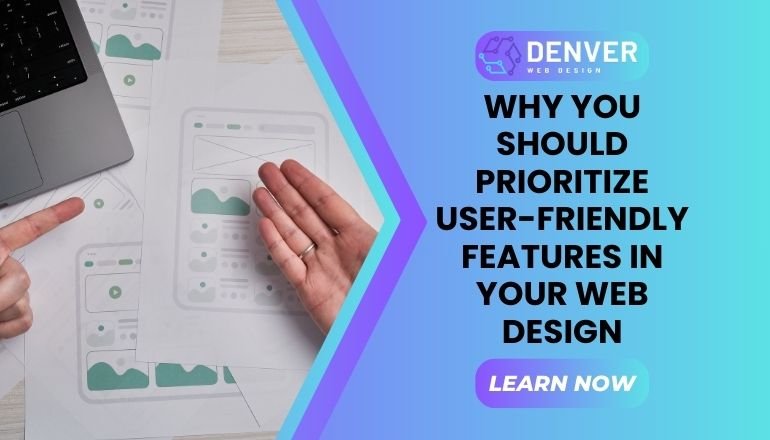
When building a website, one of the most critical factors to consider is user experience. A user-friendly website ensures that visitors can easily navigate your content, find the information they need, and perform actions like making a purchase or signing up. Prioritizing user-friendly features in web design isn’t just about aesthetics it’s about creating a seamless experience that fosters trust, encourages engagement, and drives conversions.
At Web Design Denver, we specialize in creating websites that are both visually appealing and intuitive, solving common issues businesses face when trying to enhance user experience.
What is User-Friendly Web Design?
User-friendly web design refers to a website that is designed with the end user in mind. It means that the website is easy to navigate, intuitive to use, and offers a seamless experience across all devices. Key elements of user-friendly design include clear navigation menus, fast-loading pages, mobile responsiveness, and an accessible layout that makes information easy to find.
A user-friendly website should not only look attractive but also provide practical usability that enhances the overall user experience. Terms like “responsive design,” “UX design,” and “mobile-first approach” often come into play when discussing how to create a user-friendly experience.
Why is User-Friendly Web Design Essential for Your Website?
User-friendly design is crucial for several reasons. First, it significantly impacts user experience, which directly influences customer satisfaction. A website that’s easy to navigate and visually engaging encourages visitors to spend more time on the site, increasing the chances of conversions, whether that’s a sale, a lead, or another desired action.
Moreover, user-friendly features are essential for improving SEO performance. Search engines like Google prioritize websites that provide a good user experience, including fast load times, mobile optimization, and easy navigation. Websites that meet these criteria are more likely to rank higher in search engine results, increasing visibility and attracting more organic traffic.
Key Features of User-Friendly Web Design
Several key features contribute to creating a user-friendly website, each focusing on improving the usability and accessibility of your site:
- Responsive Design: A responsive website adapts to different screen sizes, ensuring that it provides an optimal viewing experience on mobile devices, tablets, and desktops.
- Clear Navigation: Easy-to-follow menus, intuitive links, and a logical page structure ensure that users can find what they’re looking for quickly without feeling frustrated.
- Fast Load Times: Slow-loading pages can drive visitors away. Optimizing images and code can drastically improve site speed, which enhances user experience and SEO rankings.
- Consistent Visual Hierarchy: A well-organized layout with a clear visual hierarchy helps users navigate the site by guiding their attention to the most important elements, like call-to-action buttons or featured products.
- Accessibility Features: Including alt text for images, keyboard navigation, and proper color contrast makes your site accessible to all users, including those with disabilities.
- Engaging CTAs: Clear and compelling call-to-action buttons encourage users to take the next step, whether it’s purchasing a product or signing up for a newsletter.
Best Practices for User-Friendly Web Design
To create a website that is both user-friendly and effective, there are several best practices to follow:
- Simplify Navigation: Keep your site’s navigation simple and intuitive. Use a clear menu structure with logical categories and subcategories to help users find what they need.
- Mobile-First Design: Since mobile traffic continues to grow, prioritize mobile design by ensuring that your site is responsive and easy to navigate on smartphones and tablets.
- Optimize for Speed: Speed is a critical factor in both user experience and SEO. Compress images, use caching, and streamline code to make your website load faster.
- Focus on Visual Appeal: While functionality is key, aesthetics shouldn’t be neglected. Use high-quality images, consistent colors, and readable fonts to create a visually appealing design that enhances the user experience.
- User Testing: Conduct regular usability testing to identify any potential issues users may encounter. Gather feedback and make necessary adjustments to continuously improve the user experience.
Common Mistakes to Avoid in User-Friendly Web Design
Even with a focus on user experience, there are common pitfalls that web designers often fall into. Avoid these mistakes to ensure your site is truly user-friendly:
- Overcomplicating Navigation: Complex navigation menus or deep page structures can confuse users. Keep it simple and intuitive to avoid frustrating visitors.
- Ignoring Mobile Optimization: Failing to design for mobile users is a huge mistake. Ensure your website looks and functions seamlessly on all devices, as mobile users make up a significant portion of web traffic.
- Cluttered Layouts: A crowded design with too many elements can overwhelm users. Stick to a clean and organized layout with plenty of whitespace to allow your content to breathe.
- Slow Loading Times: A sluggish website is a major deterrent for users. Optimize site performance by reducing image sizes and minimizing unnecessary scripts.
- Lack of Accessibility Features: Failing to include accessibility features can alienate potential users. Make sure your website is accessible to everyone, including people with disabilities.
Conclusion: Key Takeaways
Prioritizing user-friendly features in your web design is essential for creating a website that attracts, engages, and converts visitors. By focusing on elements like responsive design, clear navigation, fast load times, and accessibility, you can improve the overall user experience and boost your site’s SEO performance. Avoid common mistakes like cluttered layouts and poor mobile optimization to ensure that your website serves your users in the best possible way. Start optimizing your web design for better user experience and increased conversions with the help of Web Design Denver today.






